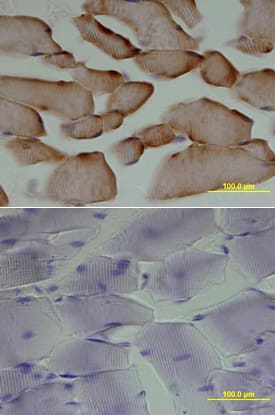Mouse HGF Antibody
R&D Systems, part of Bio-Techne | Catalog # AF2207


Key Product Details
Species Reactivity
Validated:
Cited:
Applications
Validated:
Cited:
Label
Antibody Source
Product Summary for Mouse HGF Antibody
Immunogen
Gln33-Leu728
Accession # Q53WS5
Specificity
Clonality
Host
Isotype
Scientific Data Images for Mouse HGF Antibody
HGF in Mouse Liver.
HGF was detected in perfusion fixed frozen sections of mouse liver using Goat Anti-Mouse HGF Antigen Affinity-purified Polyclonal Antibody (Catalog # AF2207) at 15 µg/mL overnight at 4 °C. Tissue was stained using the Anti-Goat HRP-DAB Cell & Tissue Staining Kit (brown; Catalog # CTS008) and counterstained with hematoxylin (blue). Lower panel shows a lack of labeling if primary antibodies are omitted and tissue is stained only with secondary antibody followed by incubation with detection reagents. View our protocol for Chromogenic IHC Staining of Frozen Tissue Sections.HGF in Mouse Skeletal Muscle.
HGF was detected in perfusion fixed frozen sections of mouse skeletal muscle using Goat Anti-Mouse HGF Antigen Affinity-purified Polyclonal Antibody (Catalog # AF2207) at 15 µg/mL overnight at 4 °C. Tissue was stained using the Anti-Goat HRP-DAB Cell & Tissue Staining Kit (brown; Catalog # CTS008) and counterstained with hematoxylin (blue). Lower panel shows a lack of labeling if primary antibodies are omitted and tissue is stained only with secondary antibody followed by incubation with detection reagents. View our protocol for Chromogenic IHC Staining of Frozen Tissue Sections.Applications for Mouse HGF Antibody
Immunohistochemistry
Sample: Perfusion fixed frozen sections of mouse skeletal muscle and mouse liver
Western Blot
Sample: Recombinant Mouse HGF (Catalog # 2207-HG)
Mouse HGF Sandwich Immunoassay
Reviewed Applications
Read 4 reviews rated 4.5 using AF2207 in the following applications:
Formulation, Preparation, and Storage
Purification
Reconstitution
Formulation
Shipping
Stability & Storage
- 12 months from date of receipt, -20 to -70 °C as supplied.
- 1 month, 2 to 8 °C under sterile conditions after reconstitution.
- 6 months, -20 to -70 °C under sterile conditions after reconstitution.
Background: HGF
HGF, also known as Scatter Factor and Hepatopoietin A, is a pleiotropic protein in the Plasminogen subfamily of S1 peptidases. It is a multidomain molecule that includes an N-terminal PAN/APPLE-like domain, four Kringle domains, and a serine proteinase-like domain that has no detectable protease activity (1‑5). Mouse HGF is secreted as an inactive 728 amino acid (aa) single chain propeptide. It is cleaved after the fourth Kringle domain by a serine protease to form bioactive disulfide‑linked HGF with a 60 kDa alpha and 30 kDa beta chain. Alternate splicing generates an isoform that lacks the peptidase and the second, third, and fourth Kringle domains. Mouse HGF shares 91%‑95% aa sequence identity with bovine, canine, feline, human, and rat HGF. HGF binds heparan-sulfate proteoglycans and the widely expressed receptor tyrosine kinase, HGF R/c-MET (6, 7). HGF-dependent c-MET activation is implicated in the development of many human cancers (8). HGF regulates epithelial morphogenesis by inducing cell scattering and branching tubulogenesis (9, 10). HGF induces the upregulation of integrin alpha2 beta1 in epithelial cells by a selective increase in alpha2 gene transcription (11). This integrin serves as a collagen I receptor, and its blockade disrupts epithelial cell branching tubulogenesis (11, 12). HGF can also alter epithelium morphology by the induction of nectin-1 alpha ectodomain shedding, an adhesion protein component of adherens junctions (13). In the thyroid, HGF induces the proliferation, motility, and loss of differentiation markers of thyrocytes and inhibits TSH-stimulated iodine uptake (14). HGF promotes the motility of cardiac stem cells in damaged myocardium (15).
References
- Karihaloo, A. et al. (2005) Nephron Exp. Nephrol. 100:e40.
- Hammond, D.E. et al. (2004) Curr. Top. Microbiol. Immunol. 286:21.
- Rosario, M. and W. Birchmeier (2004) Dev. Cell 7:3.
- Lesk, A.M. and W.D. Fordham (1996) J. Mol. Biol. 258:501.
- Sasaki, M. et al. (1994) Biochem. Biophys. Res. Commun. 199:772.
- Mizuno, K., et al. (1994) J. Biol. Chem. 269:1131.
- Gheradi, E. et al. (2003) Proc. Natl. Acad. Sci. 100:12039.
- Corso, S. et al. (2005) Trends Mol. Med. 11:284.
- Maeshima, A. et al. (2000) Kid. Int. 58:1511.
- Montesano, R. et al. (1991) Cell 67:901.
- Chiu, S-J. et al. (2002) J. Biomed. Sci. 9:261.
- Saelman, E.U.M. et al. (1995) J. Cell Sci. 108:3531.
- Tanaka, Y. et al. (2002) Biochem. Biophys. Res. Commun. 299:472.
- Mineo, R. et al. (1994) Endocrinology 145:4355.
- Urbanek, K. et al. (2005) Circ. Res. 97:663.
Long Name
Alternate Names
Entrez Gene IDs
Gene Symbol
UniProt
Additional HGF Products
Product Documents for Mouse HGF Antibody
Product Specific Notices for Mouse HGF Antibody
For research use only
